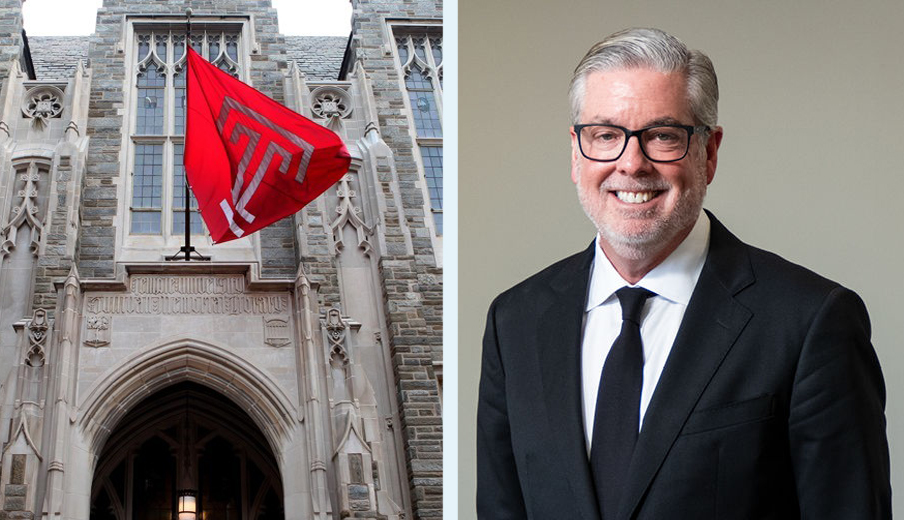Temple Is Lucky to Have John Fry — and So Is Philadelphia
Why I’m so excited about his move from Drexel to North Broad Street.

John Fry is making the leap from Drexel to Temple. / Photographs via Getty Images (left) and Temple University
Editor’s note: An earlier version of this article failed to mention the existence of the North Broad Business Improvement District and the work of the North Broad Renaissance. We regret the oversight.
“Some men see things as they are and say, why; I dream things that never were and say, why not.”
George Bernard Shaw gets the credit for coining the above quote, but it was Robert F. Kennedy (the original one) who made it famous for a new generation when he ran for President in 1968.
These days, those words make me think of a person Philadelphia is lucky to have: John Fry. That quote defines who Fry is and how he sees the world.
Fry was in the news this summer, thanks to the announcement that he’ll be stepping aside as president of Drexel to become Temple’s new president this fall. (He’ll officially start in mid-November.) I can’t think of a better choice to lead Temple, and I can’t think of better news for Philadelphia.
Fry’s great talent is providing clear leadership and a vision for a better tomorrow. That skill has been on display wherever he’s worked, including in his roles as executive vice president at Penn in the 1990s and president of Franklin and Marshall from 2002 to 2010.
But it really stood out in Fry’s 14 years leading Drexel, where he not only forged deeper ties in the university’s Mantua neighborhood (including innovative partnerships to support local schools), but also played a major role in economic development across Philadelphia.
In fact, just look at our city’s skyline. Buildings now rise in University City that didn’t exist a decade and a half ago, and a big chunk of the credit for that goes to Fry. He had the foresight to understand that Philadelphia needed to double down on important work being done here in life sciences and biotech, and together he and Jerry Sweeney from Brandywine Realty Trust led the makeover of parking lots and old industrial spaces into Schuylkill Yards — the innovation area that is helping to power Philadelphia’s 21st-century economy. In the last dozen years, Drexel has put billions into creating millions of square feet of commercial, retail and residential space, with much more still to come. That’s the biggest development Philadelphia has seen in the last 30 years.
As he transitions into his high-stakes new job — leading Philadelphia’s largest university — Fry will need to tap into his prodigious talents once again.
Temple’s enrollment declined nearly 22 percent from 2019 to 2023 — dropping from 38,000 to about 30,500. COVID played a large role in that, but so did safety issues on and near campus. A Temple police officer was tragically shot and killed in 2023, and there have been other high-profile incidents that have undermined a feeling of safety. While applications were strong for this school year, Fry needs to address the safety issue head on — you can’t do anything unless you’re in a safe environment.
At the same time, Fry needs to create and pursue strategies that will lift not just Temple, but also the school’s surrounding neighborhood in North Philadelphia. Fortunately, he knows that, telling the Inquirer not long after he was hired that Temple has the potential to play a unifying, constructive role in North Philly — something that hasn’t always been the case. “Work needs to be done there, starting with really deep listening and understanding about what neighborhood interests, issues and needs are.”
While I know Fry won’t have any shortage of ideas, here are two I offer him:
- One is to align closely with the community members and community organizations who’ve been working hard for years on behalf of the neighborhood, including the North Broad Renaissance. Earlier this year the newly formed North Broad Business Improvement District, managed by the North Broad Renaissance, began collecting extra taxes from commercial property owners along the corridor, focusing on cleaning, safety, maintenance, and business development.
- Another idea is to work with the School District of Philadelphia to integrate additional curriculum in the elementary, middle and high schools in Temple’s neighborhood with a special focus on financial literacy, technology, and entrepreneurship. And at the high school level they could adopt a model in which students spend four days a week in class and one day working (similar to Drexel’s famous co-op program or the Cristo Rey High School model). As Fry well knows from his experiences at Penn and Drexel, strong public schools can galvanize a neighborhood.
The good news is, in addition to the foundation that’s already been laid by community members in North Philadelphia, Fry should be helpful in bringing in more resources, including from the highest levels of state government. I know for a fact that Josh Shapiro is a huge admirer of Fry’s, and since Temple is a state-affiliated institution, the commonwealth should be an active partner in helping Temple move forward.
Leading Temple will be the biggest challenge of John Fry’s career — but also, potentially, the most rewarding. Penn is our marquee institution, known around the world. Drexel, particularly under Fry’s leadership, has become a nationally renowned university. But it’s Temple, with its largely working-class student body, that really represents Philadelphia’s heart. Its many graduates power our economy and local government, and their work is vital. In my real estate business, I’ve always made it a point to hire Temple grads, who bring a dedication and work ethic that’s second to none.
A decade from now, under John Fry’s leadership, I can imagine many things for Temple: that it’s stronger than ever academically and financially; that its neighbors thrive as never before; that it contributes to Philadelphia’s economic well-being in new and powerful ways.
As Fry himself might say, why not?
Allan Domb served as an at-large member of Philadelphia’s City Council from 2016 to 2022 and is president of Allan Domb Real Estate.


